In addition to myself, the installation team consisted of Greg, Daryl, Paula, George, Lloyd, Audrey, Ed, and Tom. Eight boxes had been crafted by Tom to install along the shoreline. Based on insight and the research done by Daryl we identified locations for each box. The boxes were placed on a tree approximately 3 to 5 m above ground and with a slight forward slant to prevent the accumulation of rainwater and allow easy escape for the ducklings. They were also located a minimum of 30m apart and were visually isolated from one another to prevent dump nesting and predation. Paula and Greg recorded the GPS coordinates so that we may return to the locations to monitor and maintain the boxes in the future. The boxes were filled with approximately 10cm of wood shavings and a piece of wood placed over the entrance to prevent starlings from becoming established, which will later be removed upon arrival of the cavity nesting ducks.
Six of the eight boxes were placed on the east side of the lake and the remaining two were placed on the west side. To get to the west side we walked across the lake. A few of us were a bit tentative to journey on the ice as the warm weather made us skeptical of its strength. Nonetheless, we came away unscathed and we even managed to pull Audrey across on a wagon.
When we reached the west side we discovered two nest boxes had previously been installed. In one of them we were welcomed by a couple of flying squirrels. In another we uncovered a nest which contained 17 unhatched eggs. It was decided to replace that box with a new one which was the final installation. Initially our crew was unsure as to how many boxes we were going to install; however, as the afternoon progressed we became determined to install them all, which we successfully achieved. With the successful installation of the duck boxes we now patiently await the arrival of the ducks to nest within these fresh, new spaces.
Article submitted by Myra Juckers, new member of RMN
Photos courtesy of Greg Ross



 RSS Feed
RSS Feed
